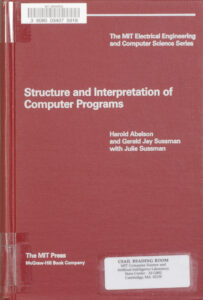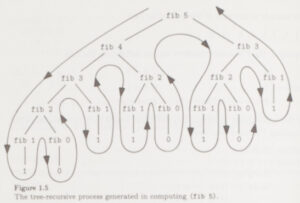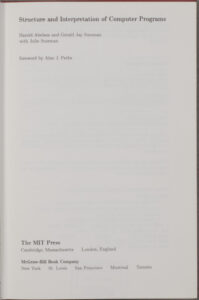Published: Cambridge, Mass., 1985
MIT is home to the planet’s most elite course in electrical engineering and computer science.
“Course 6,” as it’s known in MIT-speak, attracts the very finest students and the most distinguished faculty associated with any such program. It retains its ranking as the best in the world, at least in part, through continuous adjustment and updating of its course offerings.
During the early 1980s, as computing was becoming a ubiquitous activity that would transform the way people worked and lived their lives, Course 6’s curriculum underwent a major restructuring. Two of the signal events in that transformation were the introduction of the core class 6.001, “Structure and Interpretation of Computer Programs,” and publication of the book of the same title, by Hal Abelson and Gerald Jay Sussman, with Julie Sussman.
 Shorthanded as “SICP,” but also called “the Wizard Book,” the Abelson/Sussman text was used to teach programming to an entire generation of MIT students who enrolled in the electrical engineering program.
Shorthanded as “SICP,” but also called “the Wizard Book,” the Abelson/Sussman text was used to teach programming to an entire generation of MIT students who enrolled in the electrical engineering program.
The volume has developed a following and an aura that’s normally associated with publications of a more occult nature. The book has an entry in The New Hacker’s Dictionary, and the legendary lectures by its revered authors are available online, where they remain hugely popular.
The fact that this is no ordinary “how-to” programming book becomes clear early on – in the second paragraph of its preface, in fact – with a passage that hasn’t lost its capacity to surprise the reader:
A computer language is not just a way of getting a computer to perform operations but rather … it is a novel formal medium for expressing ideas about methodology. Thus, programs must be written for people to read, and only incidentally for machines to execute.
The book, like the MIT class for which it was  developed, didn’t merely focus on the mechanical aspects of computer programming. Instead, the goal was to teach people how to tackle large, complex problems by utilizing techniques that are “common to all of engineering design.” Abelson, Sussman and Sussman set out to teach electrical engineers a particular way to think.
developed, didn’t merely focus on the mechanical aspects of computer programming. Instead, the goal was to teach people how to tackle large, complex problems by utilizing techniques that are “common to all of engineering design.” Abelson, Sussman and Sussman set out to teach electrical engineers a particular way to think.
The class and the book were at the heart of Course 6 from the early 1980s – before the Internet even existed – until well into the first decade of the 21st century. The legendary 6.001 class was finally retired, during a major curriculum realignment, just a few years ago.
In January 2008 a blogger on the MIT admissions blog related what transpired during the final class meeting of the very last semester in which course 6.001 was offered.
A teaching assistant who spoke during that final class meeting took the floor to point out that
it was ‘remarkable that a course invented [in the 1980s was] still so dead on in what matters.’ He pointed out the remarkable insight of Abelson and Sussman to see into the core of computation, ‘keeping it fresh for more than a quarter of a century.’ And afterwards, the entire room stood up and applauded the class.

